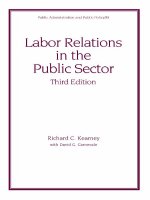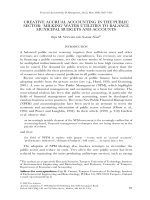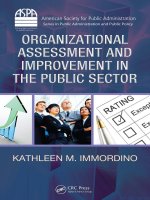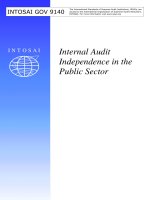Human resource management in the public sector 0857937316 dr soc
Bạn đang xem bản rút gọn của tài liệu. Xem và tải ngay bản đầy đủ của tài liệu tại đây (2.19 MB, 350 trang )
Human Resource Management in the Public
Sector
M3074 - BURKE 978857937315 PRINT.indd i
29/01/2013 15:57
NEW HORIZONS IN MANAGEMENT
Series Editor: Cary L. Cooper, CBE, Distinguished Professor of Organizational Psychology and
Health, Lancaster University, UK
This important series makes a significant contribution to the development of management
thought. This field has expanded dramatically in recent years and the series provides an
invaluable forum for the publication of high quality work in management science, human
resource management, organizational behaviour, marketing, management information
systems, operations management, business ethics, strategic management and international
management.
The main emphasis of the series is on the development and application of new original
ideas. International in its approach, it will include some of the best theoretical and empirical
work from both well-established researchers and the new generation of scholars.
Titles in the series include:
Self-Management and Leadership Development
Edited by Ronald J. Burke and Mitchell G. Rothstein
Handbook of Employee Engagement
Perspectives, Issues, Research and Practice
Edited by Simon Albrecht
Human Resource Management in Small Business
Achieving Peak Performance
Edited by Cary L. Cooper and Ronald J. Burke
Research Handbook of Comparative Employment Relations
Edited by Michael Barry and Adrian Wilkinson
Psychological Ownership and the Organizational Context
Theory, Research Evidence, and Application
Jon L. Pierce and Iiro Jussila
Handbook of Stress in the Occupations
Edited by Janice Langan-Fox and Cary L. Cooper
The New Knowledge Workers
Dariusz Jemielniak
Narcissism in the Workplace
Research, Opinion and Practice
Andrew J. DuBrin
Gender and the Dysfunctional Workplace
Edited by Suzy Fox and Terri R. Lituchy
The Innovation Imperative in Health Care Organisations
Critical Role of Human Resource Management in the Cost, Quality and Productivity
Equation
Edited by Peter Spurgeon, Cary L. Cooper and Ronald J. Burke
Human Resource Management in the Nonprofit Sector
Passion, Purpose and Professionalism
Edited by Ronald J. Burke and Cary L. Cooper
Human Resource Management in the Public Sector
Edited by Ronald J. Burke, Andrew J. Noblet and Cary L. Cooper
The Psychology of the Recession on the Workplace
Edited by Cary L. Cooper and Alexander-Stamatios G. Antoniou
How Can HR Drive Growth?
Edited by George Saridakis and Cary L. Cooper
M3074 - BURKE 978857937315 PRINT.indd ii
29/01/2013 15:57
Human Resource
Management in the
Public Sector
Edited by
Ronald J. Burke
Emeritus Professor of Organizational Studies, Schulich School
of Business, York University, Canada
Andrew J. Noblet
Professor, Deakin University, Australia
Cary L. Cooper CBE
Distinguished Professor of Organizational Psychology and
Health, Lancaster University, UK
NEW HORIZONS IN MANAGEMENT
Edward Elgar
Cheltenham, UK • Northampton, MA, USA
M3074 - BURKE 978857937315 PRINT.indd iii
29/01/2013 15:57
© Ronald J. Burke, Andrew J. Noblet and Cary L. Cooper 2013
All rights reserved. No part of this publication may be reproduced, stored in a
retrieval system or transmitted in any form or by any means, electronic,
mechanical or photocopying, recording, or otherwise without the prior
permission of the publisher.
Published by
Edward Elgar Publishing Limited
The Lypiatts
15 Lansdown Road
Cheltenham
Glos GL50 2JA
UK
Edward Elgar Publishing, Inc.
William Pratt House
9 Dewey Court
Northampton
Massachusetts 01060
USA
A catalogue record for this book
is available from the British Library
Library of Congress Control Number: 2012948158
This book is available electronically in the ElgarOnline.com
Business Subject Collection, E-ISBN 978 0 85793 732 2
ISBN 978 0 85793 731 5
04
Typeset by Servis Filmsetting Ltd, Stockport, Cheshire
Printed and bound by MPG Books Group, UK
M3074 - BURKE 978857937315 PRINT.indd iv
29/01/2013 15:57
Contents
List of figures
List of tables
List of contributors
Acknowledgements
1
The importance of human resource management in the public
sector, future challenges and the relevance of the current
collection
Ronald J. Burke, Amanda F. Allisey and Andrew J. Noblet
PART I
2
3
5
6
1
APPROACHES TO HUMAN RESOURCE
MANAGEMENT IN THE PUBLIC SECTOR
The distinctiveness of human resource management in the
public sector
Catherine Truss
Human resource management in the public sector in
developing countries
Christopher J. Rees
PART II
4
vii
viii
ix
xi
17
37
ASSESSING AND ADDRESSING THE HEALTH
AND WELL-BEING OF PUBLIC SECTOR
EMPLOYEES
Psychosocial risk factors for stress and stress claim differences
between the public and private sectors
Tessa S. Bailey, Sarven S. McLinton and Maureen F. Dollard
Building more supportive and inclusive public sector
working environments: a case study from the Australian
community health sector
Andrew J. Noblet, Kathryn Page and Tony LaMontagne
Work engagement among public and private sector dentists
Arnold B. Bakker and Jari J. Hakanen
63
90
109
v
M3074 - BURKE 978857937315 PRINT.indd v
29/01/2013 15:57
vi
7
Human resource management in the public sector
Emotional labor, job satisfaction and burnout: how each
affects the other
Mary E. Guy and Meredith A. Newman
PART III
8
9
10
11
12
13
14
15
16
HUMAN RESOURCE MANAGEMENT CHALLENGES
IN THE PUBLIC SECTOR
Management and leadership development in public service
organizations
Patrick McGurk
Employee turnover in public agencies: examining the extent
and correlates
Mark Bradbury, Jessica E. Sowa and J. Edward Kellough
Managing human resources in the public sector during
economic downturn
Parbudyal Singh and Ronald J. Burke
Motivation, job satisfaction and retention/turnover in the
public sector
Wouter Vandenabeele
Trade unions and organizational change in the public sector:
the new politics of public sector industrial relations
Miguel Martínez Lucio
PART IV
132
153
177
196
214
236
HUMAN RESOURCE MANAGEMENT PRACTICES
AND PUBLIC SECTOR PERFORMANCE
High performance work systems, performance management
and employee participation in the public sector
Pauline Stanton and Karen Manning
Human resource management and public organizational
performance: educational outcomes in the Netherlands
Laurence J. O’Toole (Jr), René Torenvlied, Agnes Akkerman
and Kenneth J. Meier
Case study of ‘peak performing’ public sector units and
successful change efforts
Michela Arnaboldi and Giovanni Azzone
Public sector human resource management education in the
United States: contemporary challenges and opportunities
for performance improvement
Jared J. Llorens
Index
M3074 - BURKE 978857937315 PRINT.indd vi
255
270
286
303
321
29/01/2013 15:57
Figures
3.1
4.1
7.1
15.1
15.2
15.3
15.4
15.5
15.6
16.1
Mapping the boundaries of HRM&D
Psychosocial safety climate model
Relationship of emotion work to personal efficacy, false
face acting, job satisfaction and burnout
The input/output approach
A summary of the indicators typology
The activity based model
Waste management performances for Scottish local
authorities (source: Audit Scotland)
Spend per pupil – secondary schools in England
aggregated by local authorities
Italian universities – efficiency and effectiveness in
student support services
Challenges facing human resource management education
43
69
135
291
292
293
295
296
296
308
vii
M3074 - BURKE 978857937315 PRINT.indd vii
29/01/2013 15:57
Tables
3.1
4.1
4.2
4.3
4.4
6.1
6.2
6.3
6.4
8.1
9.1
9.2
9.3
14.1
14.2
15.1
16.1
Key political, fiscal, and administrative features of
decentralization and the accountability for service delivery
AWB national data on stress claims by sector (weighted)
Correlations with stress claims for both the public and
private sectors
Multivariate analysis of variance in both the public and
private sectors
Regression of stress claims on associated variables
Pearson correlations between the study variables among
public sector (N 5 1632) and private sector dentists
(N 5 1124)
Differences in mean scores for job resources among
dentists in the public sector (N 5 1632) versus the private
sector (N 5 1124)
Differences in mean scores for job demands among
dentists in the public sector (N 5 1632) versus the private
sector (N 5 1124)
Differences in mean scores for work engagement and job
performance among dentists in the public sector
(N 5 1964) versus the private sector (N 5 928)
MLD goals, options and intended organizational outcomes
Variables in the analysis
Quit rates for selected US federal agencies 2009 and 2010
Determinants of US federal agency quit rates
Descriptive statistics of and correlations between main
variables in the analysis (n 5 491)
OLS regression of schools’ average standardized test
scores (CITO scores) of pupils 2010 (n 5 491)
Italian municipalities – efficiency and effectiveness in
kindergarten services
Framework of human resource management education in
the US
48
74
75
77
80
120
122
123
124
162
184
187
188
279
281
297
305
viii
M3074 - BURKE 978857937315 PRINT.indd viii
29/01/2013 15:57
Contributors
Agnes Akkerman, Radboud University, The Netherlands
Amanda F. Allisey, Deakin University, Australia
Michela Arnaboldi, Polytechnic of Milan, Italy
Giovanni Azzone, Polytechnic of Milan, Italy
Tessa S. Bailey, University of South Australia, Australia
Arnold B. Bakker, Erasmus University, The Netherlands
Mark Bradbury, Appalachian State University, USA
Ronald J. Burke, York University, Canada
Cary L. Cooper, Lancaster University, UK
Maureen F. Dollard, University of South Australia, Australia
Mary E. Guy, University of Colorado (Denver), USA
Jari J. Hakanen, Finnish Institute for Occupational Health, Finland
J. Edward Kellough, University of Georgia, USA
Tony LaMontagne, University of Melbourne, Australia
Jared J. Llorens, Louisiana State University, USA
Miguel Martínez Lucio, Manchester Business School, UK
Karen Manning, Victoria University, Australia
Sarven S. McLinton, University of South Australia, Australia
Patrick McGurk, University of Greenwich, UK
Kenneth J. Meier, Texas A & M University, USA
Meredith A. Newman, Florida International University, USA
Andrew J. Noblet, Deakin University, Australia
Laurence J. O’Toole (Jr), University of Georgia, USA
ix
M3074 - BURKE 978857937315 PRINT.indd ix
29/01/2013 15:57
x
Human resource management in the public sector
Kathryn Page, University of Melbourne, Australia
Christopher J. Rees, University of Manchester, UK
Parbudyal Singh, York University, Canada
Jessica E. Sowa, University of Colorado, Denver, USA
Pauline Stanton, Victoria University, Australia
René Torenvlied, Leiden University, The Netherlands
Catherine Truss, University of Kent, UK
Wouter Vandenabeele, Utrecht University, The Netherlands
M3074 - BURKE 978857937315 PRINT.indd x
29/01/2013 15:57
Acknowledgements
We have worked for several years in order to understand ways in which
work experiences affect individual and organizational health, and have
closely examined policies and practices that can support the effectiveness
of employees and the organizations in which they work. In this collection, we turn our attention to human resource management in the public
sector. We previously examined human resource management in the
private, nonprofit and small business sectors. During the two years in
which this collection has been realized, the public sector has come under
increased attention and scrutiny. The global economic recession has
impacted heavily on the revenue available to governments and, as a result,
severe cost-reduction measures such as service cuts, job shedding and
departmental amalgamations have been implemented in most countries.
Yet, at a time when public sector austerity measures have reached record
highs, the community’s need for welfare protection, safety services, health
care and other state-funded programs has also escalated. ‘Doing more
with less’ is now the mantra of governments at every level – local, state
and federal – irrespective of their political allegiances. In this context, it
is hard to imagine an organization’s human resources being of greater
importance than they are today. We hope this collection is of value in
these trying times.
Many people have made valuable contributions to this collection. First
and foremost, we are indebted to our contributors for all their hard work
in researching and writing their respective chapters. We have been fortunate enough to attract some of the most productive and well-credentialed
researchers in the management and behavioural sciences and we have
thoroughly enjoyed working with them in planning and shaping their
contributions. The staff at Edward Elgar have also played a pivotal role in
developing this publication, and we have greatly appreciated their encouragement and guidance. Of course, our efforts were well supported by
our respective university’s – York University, Toronto, Canada (Ronald
Burke); Deakin University, Melbourne, Australia (Andrew Noblet); and
Lancaster University, Lancaster, UK (Cary Cooper). Lastly, we would
like to pay a special tribute to our family and friends; their support can
never be underestimated when undertaking a project like this.
xi
M3074 - BURKE 978857937315 PRINT.indd xi
29/01/2013 15:57
To Susan – having a professor, researcher and writer as a partner is
never easy
Ronald J. Burke
To Belinda, Isabella, Dominique and Alex – I promise to ‘smell the roses’
more next time
Andrew J. Noblet
To the Cooper Family, big and small – Rachel, Scott, Beth, Laura, Sarah
and Devi; and to the latest arrivals Jai and Isabella
Cary L. Cooper
M3074 - BURKE 978857937315 PRINT.indd xii
29/01/2013 15:57
1.
The importance of human resource
management in the public sector,
future challenges and the relevance
of the current collection
Ronald J. Burke, Amanda F. Allisey and
Andrew J. Noblet
This volume presents current thinking and research evidence on the role of
human resource management (HRM) policies and practices in increasing
service quality, efficiency and organizational effectiveness in the public
sector. Collectively, the contributions address a pressing worldwide need
for public sector organizations to enhance the effectiveness of their products and services while at the same time accommodating tighter budgets
and greater scrutiny from governments, media and community groups.
State funded organizations such as public hospitals, ambulance services,
law enforcement agencies, schools, social welfare programs, utility providers, business development units and other publicly funded services are all
critical to the wellbeing and functioning of societies and it is in everybody’s
interests that these organizations provide timely, high quality services. In
turn, the effectiveness of these services rests heavily on the knowledge,
skill, and drive of their employees. Policies and practices involving workforce recruitment and retention, training and development, career progression, performance appraisal, employee relations and other key HRM
responsibilities can all impact on the attitudes and behaviours of employees and have the potential to undermine or enhance the effectiveness of
employees. Strategies for managing human resources (HR) therefore have
a vital role to play in ensuring that public sector agencies have the capacity to address the needs of the communities they serve and to consistently
achieve high standards of service.
The remainder of this introduction sets the stage for the chapters that
follow. We begin by recognizing the importance of focusing on HRM
in the public sector and highlight the reasons why greater attention
needs to be directed to how HR are managed in State-funded agencies.
1
M3074 - BURKE 978857937315 PRINT.indd 1
29/01/2013 15:57
2
Human resource management in the public sector
Internationally, public sector organizations face a range of social, political
and economic challenges, many of which will have serious and on-going
implications for public sector employees and the people they serve. An
important aim of this introduction is to summarize some of the key challenges confronting public sector agencies and to highlight the impact that
they will have on public sector HR. The final section of this introduction
will provide a chapter-by-chapter summary of the current collection.
WHY FOCUS ON HRM IN THE PUBLIC SECTOR?
There are four main reasons for focusing on HRM in the public sector.
These include: (1) the lack of attention given to the public sector context
in the HRM literature; (2) the importance of public sector services and
the role of human resources in delivering these services; (3) the level of
public investment in civil services and the need for agencies to maximize
this investment, and; (4) the scale of the workforce-related challenges confronting public sector agencies. The following is a more detailed discussion
of these reasons.
(1) A Lack of Attention Given to the Public Sector Context in the HRM
literature
Scholarly research and contemporary HRM texts often overlook or only
give cursory recognition to the unique characteristics of public sector
organizations (Brown, 2004). Yet, as discussed in more detail in the first
section of this collection (see Chapter 2 by Truss and Chapter 3 by Rees),
the public sector is distinct from the private sector on a number of important grounds. One of the defining features of the public sector (relative
to private sector firms) is the extent to which State-funded services are
influenced by government and its associated authorities, regulatory bodies
and elected ownership. This degree of external influence, coupled with
strong public-sector values and relatively idiosyncratic internal environments, has important implications for how HRM is practiced in the public
sector (Farnham and Horton, 1996). A key purpose for bringing together
the current collection is to focus more attention on the specific needs and
circumstances of publicly funded agencies and to examine issues such as
job stress, employee motivation, leadership, organizational change and
management education within this context. Our hope is that the heightened relevance to public sector environments will provide practitioners,
researchers and students interested in public sector HRM with a more
informed basis for examining and addressing these issues.
M3074 - BURKE 978857937315 PRINT.indd 2
29/01/2013 15:57
The importance of HRM in the public sector
3
(2) The Importance of Public Sector Services and the Role of Human
Resources in Delivering these Services
The second reason for concentrating on HRM in the public sector relates
the importance of the goods and services provided by State-funded
agencies and the impact these have on public safety, social cohesion
and national prosperity. These services range from those involving high
levels of face-to-face interactions with clients and communities such as
healthcare, education, policing, and family support services, to the public
infrastructure operations involved in roads maintenance, public transport,
water and sewage and other public utilities. There are also the more centrally administered services that involve, for example, distributing welfare
payments and health benefits, identifying labour market opportunities,
issuing passports, scrutinizing tax returns and deciding on migration
issues. In each of these cases, the decisions made by public servants and
the actions they take have the potential to significantly influence the
safety, wellbeing and living standards of the citizens concerned. In view
of the importance of the work performed by public sector employees and
employers, there are compelling ‘public interest’ reasons for ensuring we
have a strong public sector that has the capacity to consistently execute
these roles and responsibilities to a high level. The manner in which an
agency’s HR are managed can hinder or enhance this capacity and it is
therefore critical that, first, more research is directed to the specific HR
needs of public sector agencies and, second, that key stakeholders (including practitioners and researchers) continually assess the influence of HR
policies and practices in this sector.
(3) Levels of Public Investment in Civil Services and the Need for
Governments and Agencies to Maximize this Investment
There are also major financial reasons for focusing on HRM in the public
sector. As a measure of the scope and reach of public sector services,
general government expenditures in 2009 represented nearly half of GDP
on average across OECD member countries (OECD, 2011). Furthermore,
government organizations employ almost a quarter of the total workforce
in OECD countries (OECD, 2011) and, as a result, a significant proportion
of government expenditure is dedicated to wages and salaries. In the UK,
for example, the annual public sector pay bill in 2010 was 158 billion pounds
and this amount accounts for more than 1 in every 4 pounds the Government
spends (CIPD, 2010). Likewise, in the US 29.8 per cent of all direct expenditure by the states was allocated to wages and salaries during the 2001–2002
financial year (Befort, 2012). Considering the enormity of these costs, and
M3074 - BURKE 978857937315 PRINT.indd 3
29/01/2013 15:57
4
Human resource management in the public sector
the considerable budgetary pressures they create for governments and taxpayers, there is a strong need for civil services to show that these funds are
being used as efficiently as possible and that the money invested in HR has
a maximum benefit for clients and communities. This issue again highlights
the need for HR research to focus on the specific contexts in which public
sector organizations operate and to consider how matters such as employee
wellbeing, job engagement, labour turnover, leadership and organizational
changes can be best managed in this environment.
(4) The Scale of the Workforce-related Challenges Confronting Public
Sector Agencies
The fourth and final reason for concentrating on HRM in the public
sector is that, internationally, public sector organizations face unprecedented challenges in the foreseeable future. These challenges have significant implications for the size and profile of the public sector workforce,
the conditions in which employees work and the manner in which HR are
managed in this sector.
Severe cost cutting strategies such as employee lay-offs and wage freezes
One of the most pressing concerns currently facing public sector organizations is the large reductions in government spending. The global economic
downturn has impacted on government revenue at all levels – local, state
and federal – and with policy makers under pressure to reduce large budget
deficits, the responses have invariably involved significant job losses. In the
US for example, 627 000 public sector jobs were shed between June 2009
and July 2012, while Great Britain’s ‘Comprehensive Spending Review’
will reportedly result in the loss of 490 000 public sector positions between
2010–2014 (Goldfarb, 2010; Shierholz, 2012). These and other austerity
measures (for example, wage freezes, pension restrictions) pose major challenges for HR, not only in terms of recruitment, compensation and service
provision, but also in relation to job security and workforce morale.
Ongoing reforms aimed at enhancing organizational effectiveness, reducing
inefficiencies and increasing accountability to governments and user groups
The recent cuts to public sector budgets come on top of a long series
of reforms that have sought to achieve higher levels of efficiency and
effectiveness in public sector organizations. Collectively referred to as
new public management (NPM), these strategies have often involved
high-levels of organizational re-structuring (for example, departmental
mergers, privatization), stricter performance management and accountability mechanisms, and the creation of a more market-oriented culture that
M3074 - BURKE 978857937315 PRINT.indd 4
29/01/2013 15:57
The importance of HRM in the public sector
5
places greater emphasis on the needs of consumers rather than service providers (Osborne and McLaughlin, 2002; Williams, Rayner and Allinson,
2012). NPM-style reforms have been popular in both developed and
developing countries over the past 2–3 decades and, although they have
had some success, there are also indications that they have taken their toll
on the health and satisfaction of employees (Ibsen et al., 2011; Korunka et
al., 2003; Noblet and Rodwell, 2009). A key challenge facing many public
sector organizations is how they can plan and implement NPM-oriented
change programs in a way that enhances organizational effectiveness but
at the same time protects the health and wellbeing of employees.
Large increases in the volume and complexity of services required to
address community needs
At a time when governments are attempting to slim-down and rationalize
public sector programs, the demand for State-funded services has been
steadily increasing. A large proportion of this increased demand is due
to broader population trends (for example, an ageing population requiring greater health and aged care services, see the next section), however
there has also been an increase in the need for customization and personalization of services (APS, 2010). So another significant issue confronting
many public sector agencies is how they can effectively address heightened
community demands while at the same time reducing personnel costs. This
challenge will be particularly acute in the human services (healthcare, law
enforcement, education, social welfare) where the community’s needs are
particularly complex and the failure to respond to these needs can have
immediate and often severe consequences.
Important demographic shifts such as an ageing population and a shrinking
workforce
The portion of the population aged 65 and over is expected to increase
from 13.7 per cent in 2010 to 19.1 per cent in 2021 (SSA, 2011). Yet, public
health research indicates that around half to two-thirds of this increase in
life expectancy will entail a period of severe handicap (Duckett, 2005). The
number of elderly people requiring more complex, labour intensive public
services (especially healthcare) is therefore expected to rise concomitantly
over the next 1–2 decades. In the short-term, the budgetary restrictions
and staff freezes will clearly hamper an agency’s ability to meet these rising
demands, however a longer-term problem is the shrinking workforce. In
the Australian State of Victoria, for example, the portion of the population of working age (15–64 years) will reduce from 67 per cent of the State’s
population to 65 per cent in 2021 (SSA, 2011). The resultant skills shortages and competition for appropriately qualified personnel (particularly
M3074 - BURKE 978857937315 PRINT.indd 5
29/01/2013 15:57
6
Human resource management in the public sector
from the private sector) will make it increasingly difficult for public sector
services to recruit and retain sufficient numbers of qualified staff.
Already high levels of stress, dissatisfaction and other indicators of job
strain within public sector agencies
Doubts regarding the ability of public sector services to meet the current
and future needs of their communities are fuelled further by studies indicating that the public sector is already experiencing high levels of job strain.
In the UK, for example, research undertaken by the Health and Safety
Executive (HSE, 2005) found that the symptoms of work-related stress
were significantly more prevalent in the public sector than in the private
sector and that a higher proportion of public sector employees report
working while ill. Tellingly, this study also found that the symptoms of
work-related stress were heightened in occupations involving greater faceto-face contact with the public (healthcare, education, law enforcement).
The disproportionate level of stress in the public sector is in parallel with
similar reports from other countries including Australia (see Chapter 4 by
Bailey, McLinton and Dollard), the US, Denmark, Norway and Sweden
and suggest that protecting and promoting the health of public sector
employees is an international concern (Dolcos and Daley, 2009; Ibsen et
al., 2011). How agencies respond to this concern will not only impact on
public sector employees themselves, but given the links between job stress
and client-related outcomes (for example, patient satisfaction, error rates,
employee performance), will also influence the quality of services available
to communities (for example, Aiken et al., 2001; Dugan et al., 1996).
Overall, the above challenges have serious implications for the volume
and complexity of demands facing public sector organizations and the
extent to which public sector services can meet these demands. Both the
providers and the recipients of public sector services are impacted by these
issues, and hence both parties stand to benefit from research focusing on
how public sector organizations can best address these changes. An important goal of the current collection is therefore to draw greater attention to
these and other challenges and using a combination of empirical research,
literature reviews and case studies, provide practitioners with insights into
how they can be managed.
SUMMARY OF CONTENTS
The current collection has been divided into four overlapping parts:
(I) Approaches to human resource management in the public sector;
(II) Assessing and addressing the health and well-being of public sector
M3074 - BURKE 978857937315 PRINT.indd 6
29/01/2013 15:57
The importance of HRM in the public sector
7
employees; (III) Human resource challenges in the public sector; and (IV)
Human resource management practices and public sector performance.
The final section of this introduction provides a summary of each of these
parts and the chapters therein.
Part I – Approaches to Human Resource Management in the Public Sector
Part I provides an appropriate starting point for this collection by examining what is unique and different about how HR are managed in the public
sector, particularly when compared to the private sector. Importantly, this
section takes into account the HRM approaches adopted in both developed and developing countries.
Catherine Truss (Chapter 2) reports that while there are considerable
differences in the types of HRM policies and practices that exist within
the public sector, there are several characteristics that appear to be more
unique to the sector, particularly when compared to the private sector.
These characteristics include an employment relationship that is more
closely controlled by the State, and where there is less discretion available
to individual organizations; higher levels of unionization and union influence in matters such as wage determination and pension entitlements; a
greater emphasis on values concerned with fairness, openness and equality, and a generally older and more stable workforce. NPM-style reforms
have had a major impact on how HRM is practiced in the public sector
and Chapter 2 also considers the influence of these reforms.
While the vast majority of the international HRM literature focuses
on Western industrialized societies, Chris Rees (Chapter 3) discusses the
role of public HRM in developing nations. Core HRM functions are
similar across organizations in both developed and developing countries,
although contextual factors are vastly different reflecting significant political, social, economic, environmental and health-related barriers to effective service delivery. Public HRM in developing nations is seen as essential
to social and economic progress – in particular HRM policies related to
the decentralization of power and programs of nationalization, which
can help to reinforce local cultural norms. Despite recent interest in the
developing world, further research on the contextual demands and specific
environmental concerns of non-Western communities is warranted.
Part II – Assessing and Addressing the Health and Well-being of Public
Sector Employees
As mentioned earlier in this introduction, the heightened need to develop
more responsive and efficient civil services has placed significant pressure
M3074 - BURKE 978857937315 PRINT.indd 7
29/01/2013 15:57
8
Human resource management in the public sector
on public sector organizations to constantly assess how they manage their
internal environments. Part II of this collection focuses specifically on
one of the critical outcomes associated with a more dynamic and resource
conscious working environment; the health and wellbeing of public sector
employees.
The results presented in Chapter 4 support the view that public sector
workplaces have become more stressful. Here, Maureen Dollard, Tessa
Bailey and Sarven McLinton assess compensation claims for mental
stress among Australian public sector employees and find that these are
significantly higher than in the private sector. Looking to antecedents of
compensation claims, the public sector appears to be a more demanding
workplace than the private sector, particularly with respect to emotional
and psychological demands. These findings are consistent with research
from the US where public sector employees reported significantly more
demands compared to private sector workers. There are also indications
that poor communication regarding psychosocial risks and not heeding
the views of workers in the development of psychological health policies
may explain the higher stress claims in the public sector.
Andrew Noblet, Kathryn Page and Tony LaMontagne then examine
the types of strategies that public sector organizations could employ to
combat the stress associated with more demanding working environments
(Chapter 5). Specifically, the authors report on the results of an employee
health needs assessment that was designed to identify strategies (policies,
systems, practices) that could enhance the psychosocial working conditions experienced by employees working in an Australian-based community heath service. Data was collected using an organizational-wide survey
and a series of post-survey focus groups. The findings indicate that implementing strategies to improve employee control (for example, increasing
decision-making influence) and support (for example, developing a more
inclusive culture) present valuable opportunities for creating healthier and
more motivating work environments for employees working in this sector.
Further acknowledgement of the stressful nature of state-funded health
services is provided by Arnold Bakker and Jari Hakanen (Chapter 6). The
working conditions of Finnish public dentists are examined with special
attention given to the impact that healthcare reforms have had within
the public sector. Utilizing the job demands-resources (JD-R) model
the authors demonstrate that dentists operating in the public sector are
exposed to greater demands (for example, negative contacts with patients)
and fewer resources (for example, decision authority), and as a result
report lower levels of work engagement than their private sector counterparts. Interventions based on the development of greater resources are
recommended with the authors providing access to an online tool to assist
M3074 - BURKE 978857937315 PRINT.indd 8
29/01/2013 15:57
The importance of HRM in the public sector
9
with the application of the JD-R model in an organizational setting, a
useful resource for practitioners within all areas of the public sector.
Mary Guy and Meredith Newman also address the psychological and
emotional wellbeing of employees (Chapter 7). Their discussion centres
on the emotional labour involved in performing human service roles
in the public sector. Despite the rewarding nature of the work, human
services often involve a high level of emotionally-intense work that can
lead to employee burnout. The authors offer a strategic insight into
the opportunities for HRM to reduce the negative impact of emotional
labour. Providing a supportive environment that acknowledges and
actively attempts to combat the demanding nature of the work performed
by public services employees is important. Developing more appropriate
screening tools, improving training and recognizing those employees with
relevant skills relies on flexible and proactive HR policies that are integrated into the organizational framework.
Part III – Human Resource Management Challenges in the Public Sector
One of the keys to developing healthy and effective organizations, irrespective of the sector, is to recognize the challenges impacting on organizational functioning. Although the beginning of this introduction recognized
some of the important external challenges faced by public sector organizations, Part III of this collection focuses on the more prominent internal challenges including leadership development, employee motivation,
labour turnover, managing HR during economic downturn and the role
of unions in organizational change.
Managing public sector resources more efficiently and effectively is a
major goal of current public policy and, given that managers play a key
role in how agency resources are used, strategies designed to improve the
knowledge, skills and capacities of public sector managers are integral to
achieving this goal. In Chapter 8, Patrick McGurk considers how management and leadership development interventions can be used to improve
the quality and efficiency of public sector services, while also improving
employee satisfaction and wellbeing outcomes. A distinction is made
between management development (for instance, more prescriptive training designed to enhance task performance in management roles), leader
development (for instance, individually-oriented development methods
aimed at improving the managers’ ability to influence their teams more
effectively), and leadership development (for instance, collective learning and relationship building between managers that is concerned with
enhancing social capital). Further, three case studies are presented to illustrate the outcomes associated with these approaches and to highlight the
M3074 - BURKE 978857937315 PRINT.indd 9
29/01/2013 15:57
10
Human resource management in the public sector
factors that can hinder or enhance the effectiveness of management and
leadership development in public sector agencies.
In Chapter 9, Mark Bradbury, Jessica Sowa and J. Edward Kellough
examine rates of employee turnover in the public sector with an emphasis
on problematic voluntary separations. The anticipated retirement of the
baby boomer generation places enormous pressure on public sector organizations to retain valuable talent and attract suitably qualified replacements. Voluntary turnover, a case in which the employee terminates the
employment relationship when the organization arguably would prefer it
to continue, represents a significant challenge for public sector organizations. Environmental (for example, employment legislation), organizational (for example, proportion of temporary workers) and personal (for
example, age, work-family conflict) factors all contribute to voluntary
turnover. The challenge for HRM in the public sector is identified as the
development of upstream preventative strategies that can intercept the
quit process and minimize the loss of valuable talent.
The management of public sector organizations during periods of economic downturn presents a further challenge for HRM, especially in the
current climate when severe austerity measures have been introduced in
many countries throughout Europe, North America, Latin America and
Asia. Parbudyal Singh and Ronald Burke (Chapter 10) discuss the forces
contributing to an altered public sector environment and the difficulties
faced by public HRM in tough economic times. Public organizations that
are facing economic crises most often respond by downsizing and attempts
to reduce labour costs with a focus on the immediate threat to organizational survival. However, the negative short and long-term effects of
downsizing are far-reaching and a proactive, flexible approach to HRM in
economic uncertainty can create a more sustainable organization, which
maintains a high-value approach to service delivery to the public.
Consistent with the perspectives presented earlier in this introductory
chapter, Wouter Vandenabeele portrays the public sector as a constantly
changing and increasingly output-oriented environment that presents
unique challenges for HRM (Chapter 11). The attitudes and behaviours
of employees have always been critical to the performance of public
sector agencies, however in an environment characterized by heightened
demands and declining resources, the question of how to best motivate,
attract and retain becomes a critical question. ‘Public service motivation’
forms a distinct construct within the motivational literature where the
intrinsic needs associated with contributing to the wellbeing of society,
civic virtue, public interest and compassion for others are more likely to be
fulfilled through public sector work. A key aim of this chapter is to translate knowledge gained from the motivational literature (including generic
M3074 - BURKE 978857937315 PRINT.indd 10
29/01/2013 15:57
The importance of HRM in the public sector
11
and public service motivational theories) and to consider the specific
strategies public sector organizations could use to enhance the levels of
motivation, satisfaction and retention among employees.
In Chapter 12, Miguel Lucio describes the trade union as a traditional
stakeholder in public sector human relations, and a key voice in the regulation of public sector conditions. Issues of work intensification, gender
equality and performance management are more recent concerns for the
public sector and represent changes to managerial practices as well as
changes to the social fabric of societies in which public sector organizations operate. Rather than representing a stagnant historical remnant of
the bureaucratic public sector, trade unions exhibit a reciprocal relationship with modern HRM where unions respond to, and also influence,
changing management practices in the public sector. In this way, trade
unions maintain relevance in the current public sector framework, proving
to be flexible and capable of strategic influence of HRM and management
practices.
Part IV – Human Resource Management Practices and Public Sector
Performance
The final section of this publication provides a more detailed discussion of issues involving work intensification and increased performancemanagement of the public sector. The shift towards NPM ultimately
aims to improve organizational performance through the introduction of
more flexible HRM methods and increased employee input. However, the
extent to which these reforms have achieved their intended outcomes is
still a matter for debate, especially when considering the potentially damaging effects on the satisfaction and commitment of employees.
In Chapter 13, Pauline Stanton and Karen Manning begin Part IV by
discussing the role of employee participation and performance management in high performance work systems (HPWS). Although HPWS’s have
been typically associated with a range of positive attitudinal (for example,
job satisfaction) and behavioural (for example, employee performance)
outcomes, there are indications that the introduction of these systems in
public sector settings that have undergone (or are undergoing) NPM-style
reforms can lead to negative outcomes. In contexts heavily oriented to
gaining greater efficiencies and increasing the accountability of employees, efforts to devolve decision making influence have been associated
with increased responsibility and greater intensification of work. In these
contexts, performance management systems are more likely to be seen as
mechanisms for monitoring and controlling employees rather than avenues
for improved learning and development. In all, the literature reviewed in
M3074 - BURKE 978857937315 PRINT.indd 11
29/01/2013 15:57
12
Human resource management in the public sector
this chapter suggests that for HPWS’s to have their desired effect, there
needs to be close alignment and support between the ‘high performing’
systems and the broader strategies adopted by the organization.
Laurence O’Toole, Agnes Akkerman, Kenneth Meier and René
Torenvlied undertook an empirical investigation focusing on the relationship between public sector HRM and organizational performance within
the Netherlands education sector (Chapter 14). The utilization of participatory HRM practices, particularly those that seek the input of employees in decision making and provide individualized reward systems, were
directly associated with overall organizational performance (as measured
by the schools’ educational outcomes). However, some HR-related ‘red
tape’ negatively influenced organizational performance.
Giovanni Azzone and Michela Arnaboldi (Chapter 15) further examine
performance within the public sector and evaluate the HRM activities of
peak performing public organizations. Arnaboldi and Azzone suggest that
the disparities between high and low performing public sector organizations may, to a certain extent, be attributed to the adoption and execution
of key HRM practices developing from the NPM framework. Internal
drivers of peak performance revolve around a pervasive organizationwide commitment to performance, the ability to identify and address gaps
in competences, a high degree of flexibility and ability to rapidly respond
to external influences, and a consolidation of successful processes into the
fabric of the organization. Ultimately, the ability of public sector organizations to recognize and respond to external opportunities through innovative HRM policies is a key determinant of organizational performance.
The final chapter of this publication (Chapter 16) takes us from the
work environment to the classroom. Jared Llorens examines how recent
changes to HRM practice have informed the education of public sector
managers and HR professionals. In the future, public sector HRM leaders
will be required to utilize more flexible approaches to managing employees, reflecting the changing nature of the sector. The use of more flexible
employment contracts and compensation strategies, recruitment methods
geared towards a younger and more transient workforce, as well as a
greater reliance on technology are now important components of education for public HR practitioners.
REFERENCES
Aiken, L.H., S.P. Clarke, D.M. Sloane, J.A. Sochalski, R. Busse, H. Clarke,
P. Giovannetti, J. Hunt, A.M. Rafferty and J. Shamian (2001), ‘Nurses’ reports
on hospital care in five countries’, Health Affairs, 20, 43–53.
M3074 - BURKE 978857937315 PRINT.indd 12
29/01/2013 15:57
The importance of HRM in the public sector
13
APS (2010), Why is a strong Australian Public Service important?, Canberra: APS.
Befort, S.F. (2012), ‘Public-sector employment under siege’, Indiana Law Journal,
87 (1), 231–8.
Brown, K. (2004), ‘Human resource management in the public sector’, Public
Management Review, 6 (3), 303–9.
CIPD (2010), Delivering More with Less: The People Management Challenge, UK:
Chartered Institute of Personnel and Development.
Dolcos, S. and D. Daley (2009), ‘Work pressure, workplace social resources, and
work–family conflict: the tale of two sectors’, International Journal of Stress
Management, 16 (4), 291–311.
Duckett, S.J. (2005), ‘Health workforce design for the 21st century’, Australian
Health Review, 29 (2), 201–10.
Dugan, J., E. Lauer, Z. Bouquot, B.K. Dutro, M. Smith and G. Widmeyer (1996),
‘Stressful nurses: the effect on patient outcomes’, Journal of Nursing Care
Quality, 10, 46–58.
Farnham, D. and S. Horton (1996), ‘Continuity and change in the public services’,
in D. Farnham and S. Horton (eds), Managing People in the Public Services,
Basingstoke: Macmillan, 3–42.
Goldfarb, M. (2010), ‘Britain: a new era begins with government spending’,
GlobalPost, 20 October 2010.
HSE (2005), Survey of Workplace Absence Sickness and (Ill)Health, UK: Health
and Safety Executive.
Ibsen, C.L., T.P. Larsen, J.S. Madsen and J. Due (2011), ‘Challenging Scandinavian
employment relations: the effects of new public management reforms’, The
International Journal of Human Resource Management, 22 (11), 2295–310.
Korunka, C., D. Scharitzer, P. Carayons and F. Sainfort (2003), ‘Employee strain
and job satisfaction related to an implementation of quality in a public service
organization: a longitudinal study’, Work & Stress, 17, 52–72.
Noblet, A.J. and J.J. Rodwell (2009), ‘Integrating job stress and social exchange
theories to predict employee strain in reformed public sector organisations’,
Journal of Public Administration Research and Theory, 19 (3), 555–78.
OECD (2011), Government at a Glance 2011, Paris: Organisation for Economic
Co-operation and Development (OECD).
Osborne, S.P. and K. McLaughlin (2002), ‘The new public management in context’,
in K. McLaughlin, S.P. Osborne and E. Ferlie (eds), New Public Management:
Current Trends and Future Prospects, London: Routledge, pp. 7–14.
Shierholz, H. (2012), The Labor Market is Treading Water, USA: Economic Policy
Institute.
SSA (2011), State of the Public Sector in Victoria 2010-11, Melbourne: State
Services Authority.
Williams, H.M., J. Rayner and C.W. Allinson (2012), ‘New public management
and organisational commitment in the public sector: testing a mediation model’,
International Journal of Human Resource Management, 23 (13), 2615–29.
M3074 - BURKE 978857937315 PRINT.indd 13
29/01/2013 15:57









